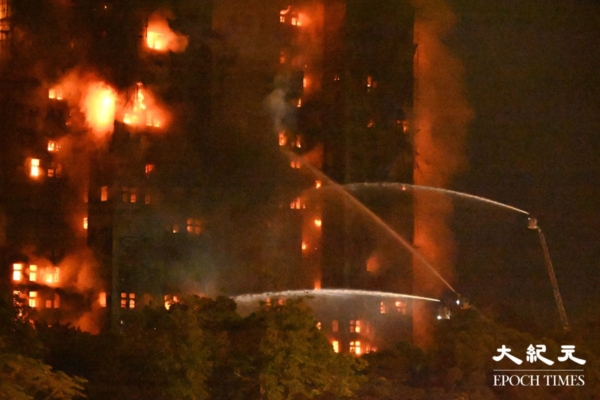A massive fire broke out in the Kam Fuk Court residential building in the Tai Po district of Hong Kong’s New Territories on the afternoon of November 26. The fire quickly spread to seven buildings, resulting in 44 confirmed deaths and 279 people still missing. Nearly ten thousand residents were affected by the disaster, with a higher proportion being elderly individuals. According to sources, this tragedy is considered a “man-made disaster” caused by multiple factors.
At 2:51 pm on November 26, flames ignited on the exterior scaffolding of the Kam Fuk Court’s Hung Cheong House. The fire escalated rapidly and by 6:22 pm, it was classified as a level five fire. The blaze spread upwards along the external scaffolding, engulfing buildings such as Hung Tai House and Hung Sun House, with the scene illuminated by flames and thick smoke billowing into the sky.
Local reports indicated that as of around 3 am on November 27, the fire was still intense on some floors, preventing firefighters from reaching units where assistance was requested.
As of the latest update, three buildings showed no signs of fire from the outside, while sporadic flames were still visible in the remaining four buildings. The fire has claimed the lives of 44 individuals and left 58 injured, with 279 people still unaccounted for.
Councilor Li Man-kit of the Tai Po district in Hong Kong mentioned that the disaster affected around 8,000 to 10,000 residents across five buildings, with a higher number of elderly individuals among them.
On the early morning of November 27, Hong Kong’s Secretary for Security, John Lee, stated that based on preliminary investigations, the possibility of criminal activity in the fire incident cannot be ruled out. The case has been handed over to the Hong Kong police for further inquiry, and earlier, three individuals responsible for the maintenance company of the building were arrested on suspicion of manslaughter.
This inferno at Kam Fuk Court marks the second fire incident within a month caused by exterior wall repairs. Last month, a level three fire broke out at the Wah Mow Building in Central Hong Kong, also related to exterior scaffolding works.
The five-alarm fire at Kam Fuk Court in Tai Po has sparked widespread public concern and scrutiny.
A knowledgeable individual named Scott from Hong Kong shared insights on social media about multiple safety hazards observed during the incident.
He pointed out that some residents mentioned the fire alarm did not sound when the fire broke out, resulting in sudden smoke infiltration that hindered many from escaping. In addition, several netizens and residents posted photos and videos suggesting workers smoking and littering cigarette butts in the repair scaffolding, despite earlier warnings from residents to refrain from smoking.
Scott revealed that in early 2024, the Kam Fuk Court Owners’ Corporation approved a repair plan costing around 330 million Hong Kong dollars, covering approximately 1,984 units across eight buildings, with each household bearing costs ranging from 160,000 to 180,000 Hong Kong dollars. To cut expenses, the repairs were concurrently conducted in eight buildings.
He mentioned that the protective nets used did not meet the latest government-mandated fire-resistant standards but were composed of ordinary flame-retardant materials. “The so-called flame retardancy did not work effectively, and the scaffolding was even more sturdy than the protective nets, indicating the issue lay in the lack of fire-resistant nets.”
Scott further highlighted that being a private residential estate, the repair works were contracted to builders by the Owners’ Corporation. “Private projects are not required to adhere strictly to government standards like those for public projects regarding fire safety regulations, so the use of bamboo scaffolding and regular flame-retardant nets, while legal, poses significant risks.”
He also mentioned the influx of foreign labor in Hong Kong in recent years but emphasized the absence of corresponding regulatory frameworks. The practice of “passing the buck” in Hong Kong’s engineering projects has become routine, with cost-cutting measures leading to the lowest-tier workers earning minimal wages, inadequate training, and limited supervision.
“This is not a standalone incident but a result of cost-driven repair decisions and loose regulatory systems, compounded by the lack of fire-resistant nets and weak safety culture, accumulating layer by layer,” Scott concluded.

